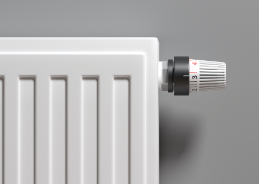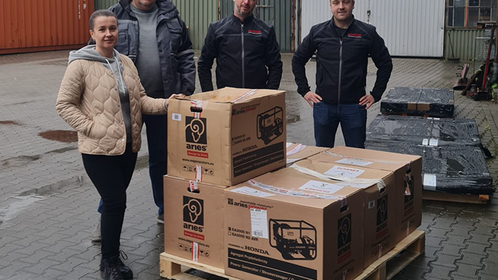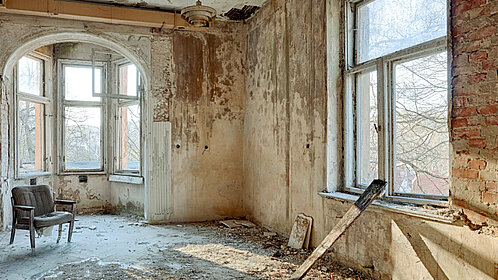Reducing heating costs – 10 tips for cheaper heating

Heating is essential to keep your home toasty warm in winter. Naturally, this costs money, but it can always be done a little more cheaply! With our 10 simple tips, you can make lasting savings on heating costs – and at the same time reduce your energy consumption and do something good for the environment.
Tip 1
Good insulation is half the battle
It is indisputable that: Proper insulation saves heating costs, but not only external walls need to be well insulated. The heating pipes themselves also radiate a lot of heat – usually in the unheated basement. This can cost you up to 14 euros a year – per metre of pipework! You can change that very quickly. Simply head to your local DIY store where you can get insulation for your heating pipes for a maximum of 10 euros per metre. Make sure that the insulation material is about the same thickness as the pipes and is applied without gaps.
Tip 2
What level of warmth required where?
Different rooms need different temperatures. Be sure to heat each room only as much as is appropriate for its purpose. In the living room, most people feel most comfortable at around 22 degrees. In the bedroom, 18 degrees is usually sufficient; in rarely used rooms even 16 degrees will do. Close doors between rooms with different temperatures to prevent heat loss and mould growth. Moreover, less heat is usually needed at night. A simple reduction of three degrees in the living room, unused at night, can achieve heating cost savings of up to ten percent.
Tip 3
The nasty little leaks
Leaks, of course, have an absolutely negative effect on your energy consumption and heating costs. The usual suspects are windows and doors. To check for leaks, you can clamp a banknote or a sheet of paper between the frame and the door or window. If you can simply pull the paper out when the door or window is closed, it is not closing tightly enough. You can remedy this quite easily. With windows, new sealing profiles or an adjustment of the sashes can work wonders. Doors can be upgraded with seals such as weatherstrips.
Tip 4
New is sometimes better
Innovations to your home or heating system can result in considerable cost savings. This applies to building materials and insulation materials, as well as to individual components. Ideally, you should replace your heating circulation pump every ten years. A new model consumes less energy and can save you up to 130 euros a year.

Speaking of renewals:
Did you know that a heat pump also works in conjunction with radiators? Although in most cases underfloor or wall heating is used in new buildings, the use of a heat pump is also possible with traditional radiators. A heat pump can therefore also be installed as part of a modernisation project.
Tip 5
A little more space, please!
While we're on the subject of radiators: of course, they are not really the highlight of your interior design. Nevertheless, you shouldn't hide them. Furniture or curtains prevent the outflowing air from being distributed efficiently in the room. Therefore, make sure that each radiator is unencumbered and clearly visible so the heat can find its way easily into the room. Furniture should be at least 30 centimetres away from these heat sources and curtains should end above them. Decorative covers may make radiators nicer to look at, but unfortunately they also decrease their effectiveness. Cleanliness is important too – a thick layer of dust is not conducive to heating performance.
Tip 6
Baby steps to the right temperature
If you have a central thermostat, set it to the temperature you want straight away – even for the initial heat-up phase. If you are not quite sure what your personal comfort temperature is, start fairly low then edge your way up, degree by degree. The same applies to radiator thermostats. As a rule of thumb, number 3 corresponds to about 20 degrees. There is a difference of about three degrees between each number. Set the thermostat to the temperature you want the room to be heated to. If a change is needed, turn the thermostat a little at a time.
Tip 7
No gurgling!
Another tip if you have radiators: air in the pipes makes for irregular heating performance and higher energy consumption. Fortunately, it also makes itself heard with a clearly audible gurgling noise. If you hear this from your radiators, you can release the air in a few simple steps:
- Check the pressure in the heating system and top up with water if necessary (in apartment buildings, ask the caretaker to do this)
- Turn the radiators on full and let them get warm
- If you have several storeys, start on the lowest one
- Place a container under the air vent valve
- Open the valve with the appropriate bleed key
- Wait until the air has escaped and only water comes out (caution – hot!)
- Close the valve again and turn off the radiator if necessary

Tip 8
A breath of fresh air!
It may sound illogical, but airing rooms regularly also helps you save energy and therefore money – at least, if you do it right. In winter, it is important not to leave windows and doors open all the time. If this is necessary for any reason, be sure to turn off the radiators in those areas. Otherwise, the keywords are "impact ventilation". This involves opening your windows several times a day for just a few minutes. Air exchange can then take place without the internal walls cooling down. It works best if you create a draught by opening windows or doors on the opposite side of the room too. You should also switch the radiators off during impact ventilation and only switch them back on when the windows are closed again.
Tip 9
Stay grounded
It's almost a trick of the mind. Some floor coverings give us a warmer feeling than others. You may know the difference if you have both wooden and tiled floors in your home. Basically, wood creates a warm, natural feeling in the living space. But the ultimate tip is rugs and carpets. A carpet on the floor can increase your perception of warmth by a whole two degrees. This makes you more likely to keep your hands off the thermostat.

Tip 10
Energy saving hero: the heat pump
The best for last: a heat pump is wonderfully efficient and environmentally friendly compared to other heating systems. Since only a quarter of the energy required comes from the socket, it is also unbeatable in terms of running heating costs. It is also the only central heating system that allows you to cool your home as well – making it an energy saving alternative to typical air conditioning systems in the warmer months of the year. And it will eventually be summer again!
Would you like to do the environment and your wallet a favour with a new heat pump?
We would be happy to advise you – contact us right away!






